Professional Accountability and Patient Safety: A Case Study Report
VerifiedAdded on 2022/12/15
|9
|2569
|156
Report
AI Summary
This report presents a detailed analysis of a case involving a registered nurse, Naomi Rayner, and her interactions with Patient A. The report explores the background of the case, highlighting the nurse's actions and omissions that led to adverse patient outcomes. It discusses the system-based failures and evidence-based approaches relevant to the case, including breaches of professional boundaries, improper recording of medication, and unethical conduct. The analysis emphasizes the importance of adhering to professional standards, maintaining appropriate boundaries, and the consequences of misconduct. The report concludes by summarizing the key findings and implications for healthcare professionals, emphasizing the need for accountability, ethical practice, and the importance of patient safety. The case underscores the critical role of supervision, support systems, and adherence to established policies in preventing similar incidents and ensuring quality patient care.
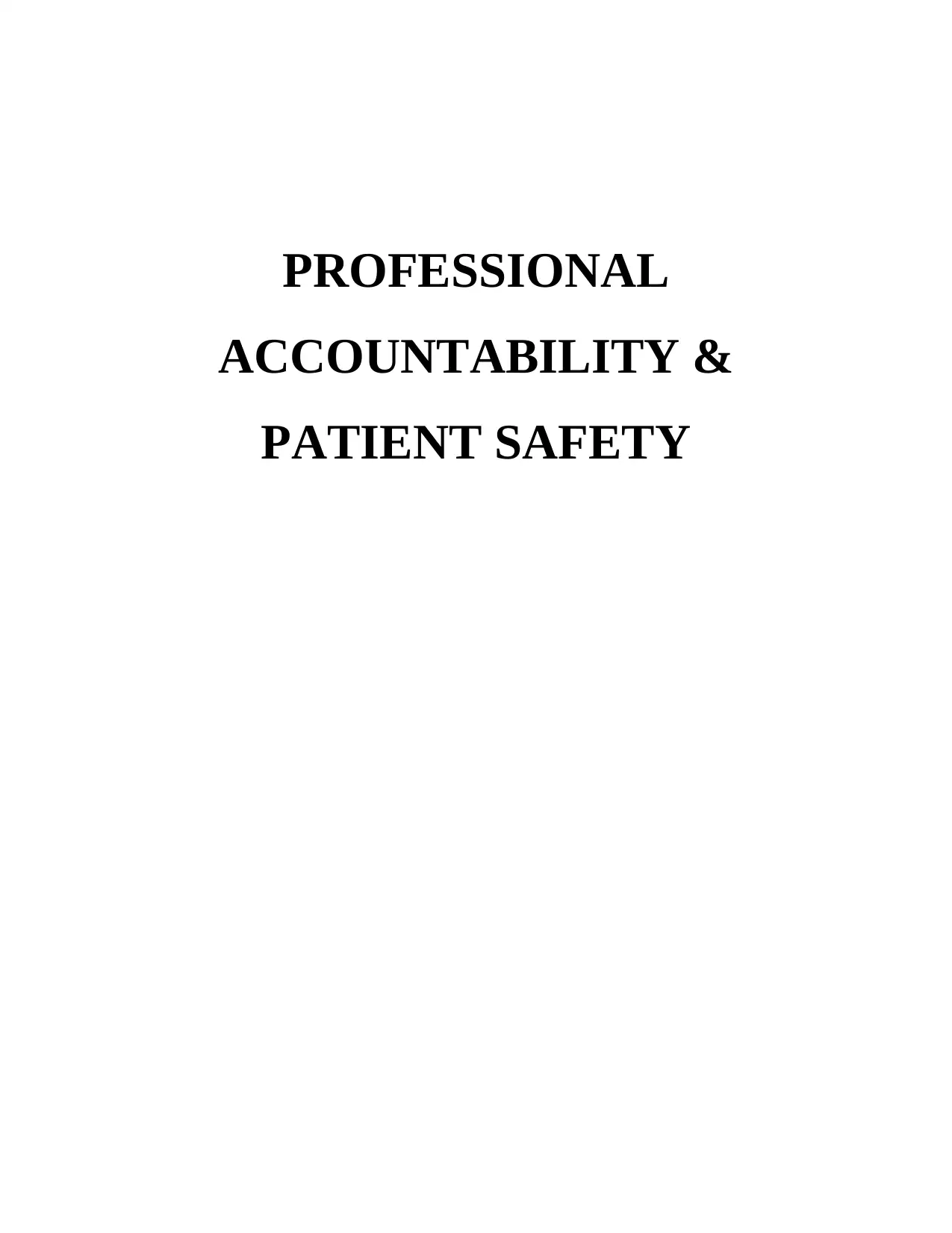
PROFESSIONAL
ACCOUNTABILITY &
PATIENT SAFETY
ACCOUNTABILITY &
PATIENT SAFETY
Paraphrase This Document
Need a fresh take? Get an instant paraphrase of this document with our AI Paraphraser
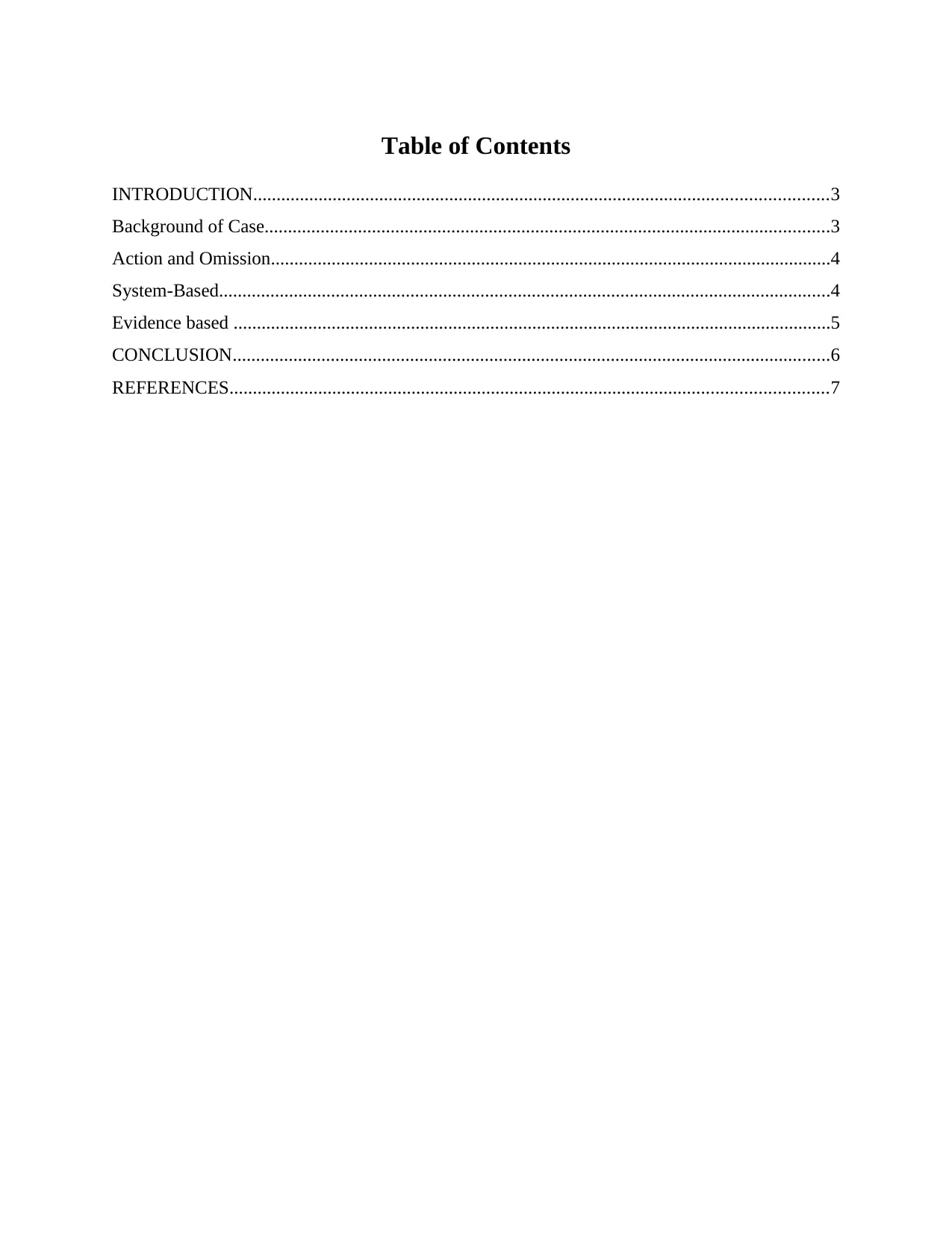
Table of Contents
INTRODUCTION...........................................................................................................................3
Background of Case.........................................................................................................................3
Action and Omission........................................................................................................................4
System-Based...................................................................................................................................4
Evidence based ................................................................................................................................5
CONCLUSION................................................................................................................................6
REFERENCES................................................................................................................................7
INTRODUCTION...........................................................................................................................3
Background of Case.........................................................................................................................3
Action and Omission........................................................................................................................4
System-Based...................................................................................................................................4
Evidence based ................................................................................................................................5
CONCLUSION................................................................................................................................6
REFERENCES................................................................................................................................7
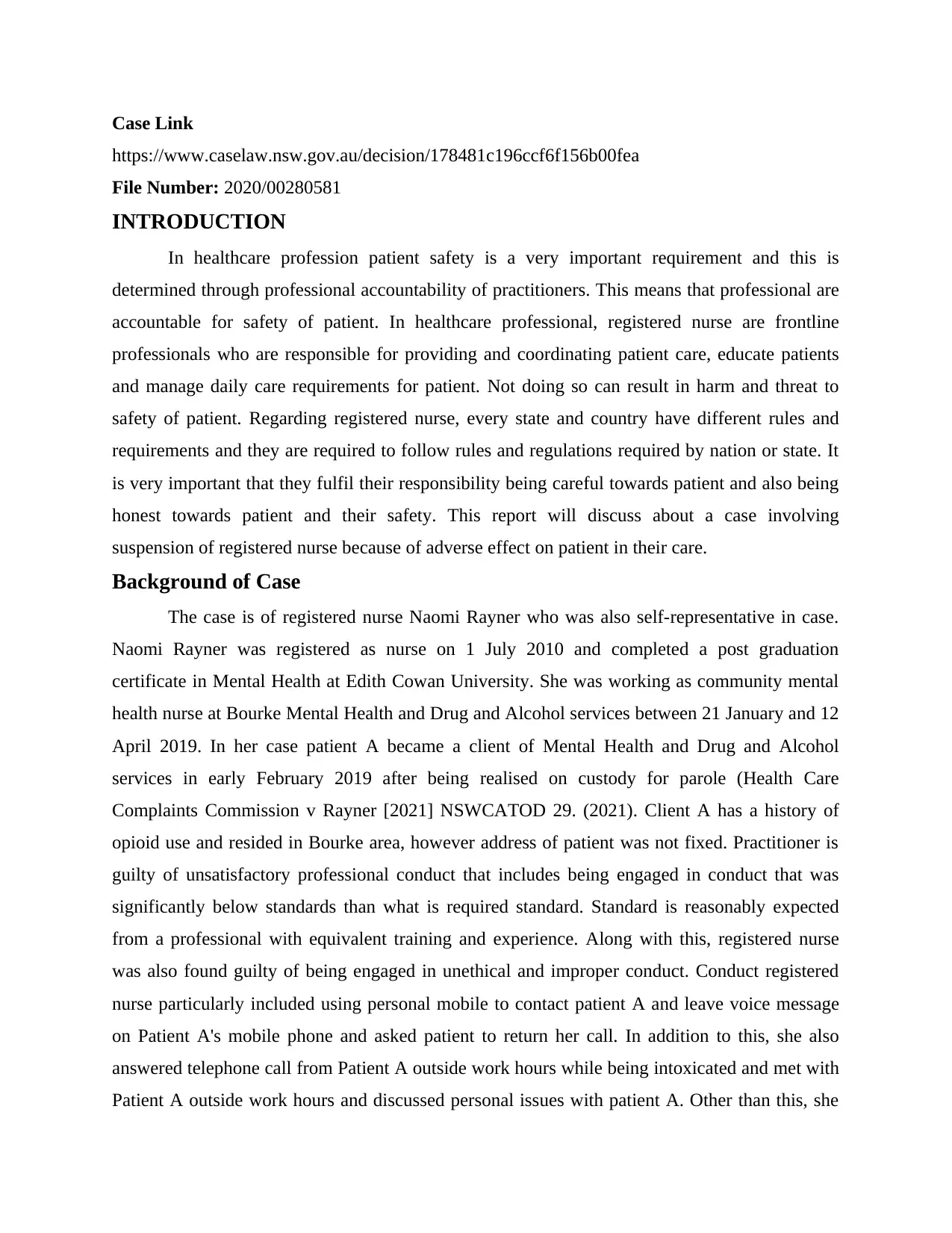
Case Link
https://www.caselaw.nsw.gov.au/decision/178481c196ccf6f156b00fea
File Number: 2020/00280581
INTRODUCTION
In healthcare profession patient safety is a very important requirement and this is
determined through professional accountability of practitioners. This means that professional are
accountable for safety of patient. In healthcare professional, registered nurse are frontline
professionals who are responsible for providing and coordinating patient care, educate patients
and manage daily care requirements for patient. Not doing so can result in harm and threat to
safety of patient. Regarding registered nurse, every state and country have different rules and
requirements and they are required to follow rules and regulations required by nation or state. It
is very important that they fulfil their responsibility being careful towards patient and also being
honest towards patient and their safety. This report will discuss about a case involving
suspension of registered nurse because of adverse effect on patient in their care.
Background of Case
The case is of registered nurse Naomi Rayner who was also self-representative in case.
Naomi Rayner was registered as nurse on 1 July 2010 and completed a post graduation
certificate in Mental Health at Edith Cowan University. She was working as community mental
health nurse at Bourke Mental Health and Drug and Alcohol services between 21 January and 12
April 2019. In her case patient A became a client of Mental Health and Drug and Alcohol
services in early February 2019 after being realised on custody for parole (Health Care
Complaints Commission v Rayner [2021] NSWCATOD 29. (2021). Client A has a history of
opioid use and resided in Bourke area, however address of patient was not fixed. Practitioner is
guilty of unsatisfactory professional conduct that includes being engaged in conduct that was
significantly below standards than what is required standard. Standard is reasonably expected
from a professional with equivalent training and experience. Along with this, registered nurse
was also found guilty of being engaged in unethical and improper conduct. Conduct registered
nurse particularly included using personal mobile to contact patient A and leave voice message
on Patient A's mobile phone and asked patient to return her call. In addition to this, she also
answered telephone call from Patient A outside work hours while being intoxicated and met with
Patient A outside work hours and discussed personal issues with patient A. Other than this, she
https://www.caselaw.nsw.gov.au/decision/178481c196ccf6f156b00fea
File Number: 2020/00280581
INTRODUCTION
In healthcare profession patient safety is a very important requirement and this is
determined through professional accountability of practitioners. This means that professional are
accountable for safety of patient. In healthcare professional, registered nurse are frontline
professionals who are responsible for providing and coordinating patient care, educate patients
and manage daily care requirements for patient. Not doing so can result in harm and threat to
safety of patient. Regarding registered nurse, every state and country have different rules and
requirements and they are required to follow rules and regulations required by nation or state. It
is very important that they fulfil their responsibility being careful towards patient and also being
honest towards patient and their safety. This report will discuss about a case involving
suspension of registered nurse because of adverse effect on patient in their care.
Background of Case
The case is of registered nurse Naomi Rayner who was also self-representative in case.
Naomi Rayner was registered as nurse on 1 July 2010 and completed a post graduation
certificate in Mental Health at Edith Cowan University. She was working as community mental
health nurse at Bourke Mental Health and Drug and Alcohol services between 21 January and 12
April 2019. In her case patient A became a client of Mental Health and Drug and Alcohol
services in early February 2019 after being realised on custody for parole (Health Care
Complaints Commission v Rayner [2021] NSWCATOD 29. (2021). Client A has a history of
opioid use and resided in Bourke area, however address of patient was not fixed. Practitioner is
guilty of unsatisfactory professional conduct that includes being engaged in conduct that was
significantly below standards than what is required standard. Standard is reasonably expected
from a professional with equivalent training and experience. Along with this, registered nurse
was also found guilty of being engaged in unethical and improper conduct. Conduct registered
nurse particularly included using personal mobile to contact patient A and leave voice message
on Patient A's mobile phone and asked patient to return her call. In addition to this, she also
answered telephone call from Patient A outside work hours while being intoxicated and met with
Patient A outside work hours and discussed personal issues with patient A. Other than this, she
⊘ This is a preview!⊘
Do you want full access?
Subscribe today to unlock all pages.

Trusted by 1+ million students worldwide
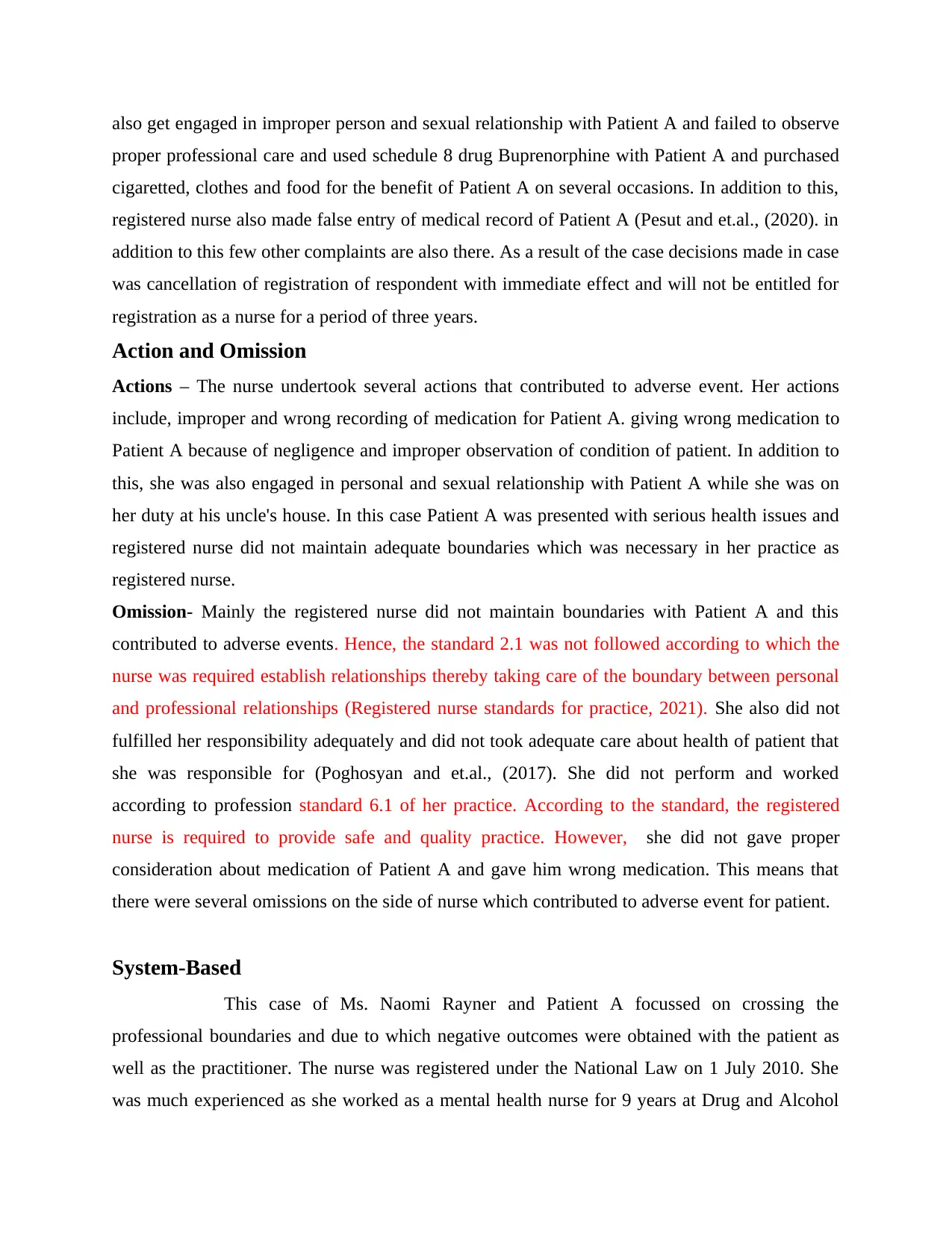
also get engaged in improper person and sexual relationship with Patient A and failed to observe
proper professional care and used schedule 8 drug Buprenorphine with Patient A and purchased
cigaretted, clothes and food for the benefit of Patient A on several occasions. In addition to this,
registered nurse also made false entry of medical record of Patient A (Pesut and et.al., (2020). in
addition to this few other complaints are also there. As a result of the case decisions made in case
was cancellation of registration of respondent with immediate effect and will not be entitled for
registration as a nurse for a period of three years.
Action and Omission
Actions – The nurse undertook several actions that contributed to adverse event. Her actions
include, improper and wrong recording of medication for Patient A. giving wrong medication to
Patient A because of negligence and improper observation of condition of patient. In addition to
this, she was also engaged in personal and sexual relationship with Patient A while she was on
her duty at his uncle's house. In this case Patient A was presented with serious health issues and
registered nurse did not maintain adequate boundaries which was necessary in her practice as
registered nurse.
Omission- Mainly the registered nurse did not maintain boundaries with Patient A and this
contributed to adverse events. Hence, the standard 2.1 was not followed according to which the
nurse was required establish relationships thereby taking care of the boundary between personal
and professional relationships (Registered nurse standards for practice, 2021). She also did not
fulfilled her responsibility adequately and did not took adequate care about health of patient that
she was responsible for (Poghosyan and et.al., (2017). She did not perform and worked
according to profession standard 6.1 of her practice. According to the standard, the registered
nurse is required to provide safe and quality practice. However, she did not gave proper
consideration about medication of Patient A and gave him wrong medication. This means that
there were several omissions on the side of nurse which contributed to adverse event for patient.
System-Based
This case of Ms. Naomi Rayner and Patient A focussed on crossing the
professional boundaries and due to which negative outcomes were obtained with the patient as
well as the practitioner. The nurse was registered under the National Law on 1 July 2010. She
was much experienced as she worked as a mental health nurse for 9 years at Drug and Alcohol
proper professional care and used schedule 8 drug Buprenorphine with Patient A and purchased
cigaretted, clothes and food for the benefit of Patient A on several occasions. In addition to this,
registered nurse also made false entry of medical record of Patient A (Pesut and et.al., (2020). in
addition to this few other complaints are also there. As a result of the case decisions made in case
was cancellation of registration of respondent with immediate effect and will not be entitled for
registration as a nurse for a period of three years.
Action and Omission
Actions – The nurse undertook several actions that contributed to adverse event. Her actions
include, improper and wrong recording of medication for Patient A. giving wrong medication to
Patient A because of negligence and improper observation of condition of patient. In addition to
this, she was also engaged in personal and sexual relationship with Patient A while she was on
her duty at his uncle's house. In this case Patient A was presented with serious health issues and
registered nurse did not maintain adequate boundaries which was necessary in her practice as
registered nurse.
Omission- Mainly the registered nurse did not maintain boundaries with Patient A and this
contributed to adverse events. Hence, the standard 2.1 was not followed according to which the
nurse was required establish relationships thereby taking care of the boundary between personal
and professional relationships (Registered nurse standards for practice, 2021). She also did not
fulfilled her responsibility adequately and did not took adequate care about health of patient that
she was responsible for (Poghosyan and et.al., (2017). She did not perform and worked
according to profession standard 6.1 of her practice. According to the standard, the registered
nurse is required to provide safe and quality practice. However, she did not gave proper
consideration about medication of Patient A and gave him wrong medication. This means that
there were several omissions on the side of nurse which contributed to adverse event for patient.
System-Based
This case of Ms. Naomi Rayner and Patient A focussed on crossing the
professional boundaries and due to which negative outcomes were obtained with the patient as
well as the practitioner. The nurse was registered under the National Law on 1 July 2010. She
was much experienced as she worked as a mental health nurse for 9 years at Drug and Alcohol
Paraphrase This Document
Need a fresh take? Get an instant paraphrase of this document with our AI Paraphraser
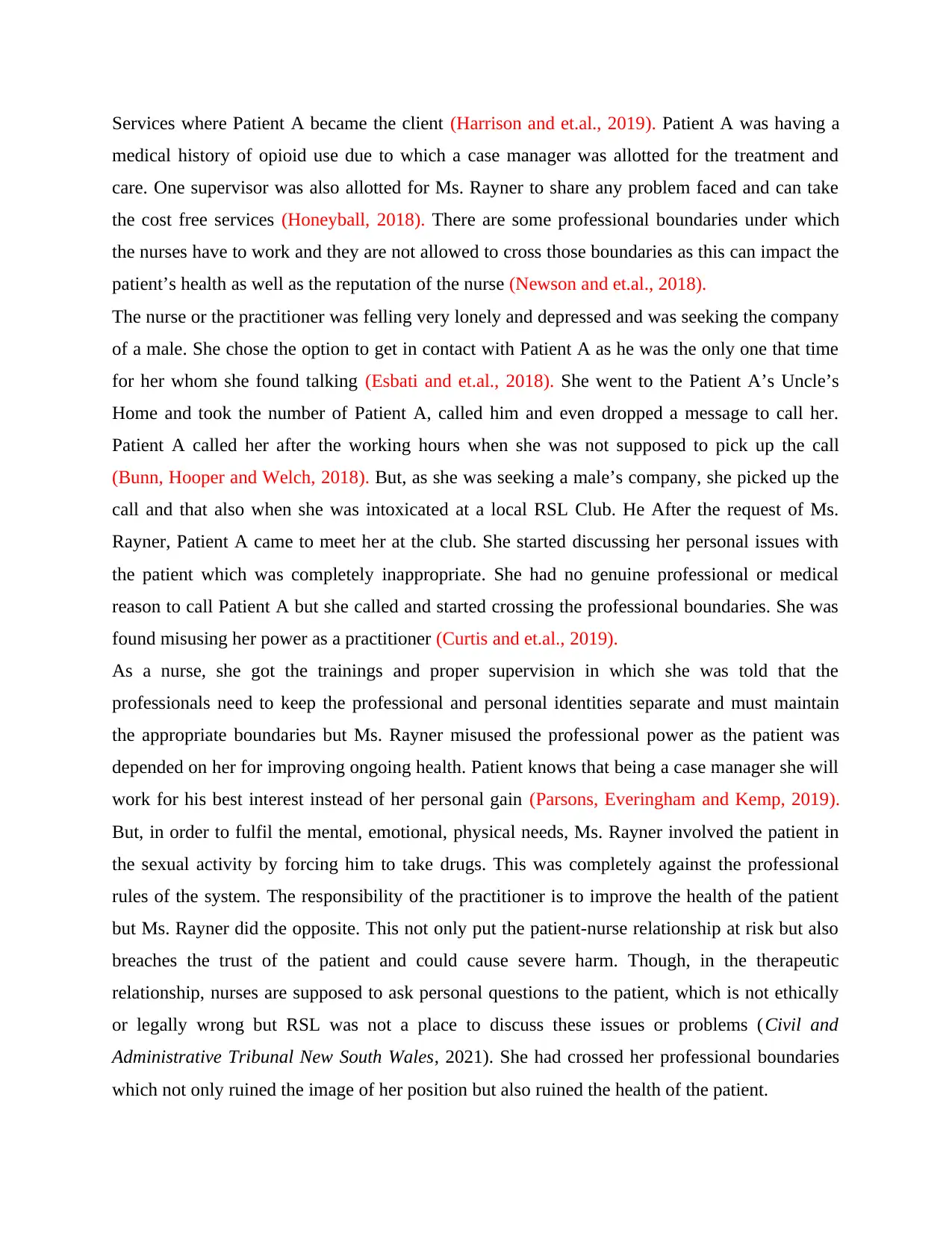
Services where Patient A became the client (Harrison and et.al., 2019). Patient A was having a
medical history of opioid use due to which a case manager was allotted for the treatment and
care. One supervisor was also allotted for Ms. Rayner to share any problem faced and can take
the cost free services (Honeyball, 2018). There are some professional boundaries under which
the nurses have to work and they are not allowed to cross those boundaries as this can impact the
patient’s health as well as the reputation of the nurse (Newson and et.al., 2018).
The nurse or the practitioner was felling very lonely and depressed and was seeking the company
of a male. She chose the option to get in contact with Patient A as he was the only one that time
for her whom she found talking (Esbati and et.al., 2018). She went to the Patient A’s Uncle’s
Home and took the number of Patient A, called him and even dropped a message to call her.
Patient A called her after the working hours when she was not supposed to pick up the call
(Bunn, Hooper and Welch, 2018). But, as she was seeking a male’s company, she picked up the
call and that also when she was intoxicated at a local RSL Club. He After the request of Ms.
Rayner, Patient A came to meet her at the club. She started discussing her personal issues with
the patient which was completely inappropriate. She had no genuine professional or medical
reason to call Patient A but she called and started crossing the professional boundaries. She was
found misusing her power as a practitioner (Curtis and et.al., 2019).
As a nurse, she got the trainings and proper supervision in which she was told that the
professionals need to keep the professional and personal identities separate and must maintain
the appropriate boundaries but Ms. Rayner misused the professional power as the patient was
depended on her for improving ongoing health. Patient knows that being a case manager she will
work for his best interest instead of her personal gain (Parsons, Everingham and Kemp, 2019).
But, in order to fulfil the mental, emotional, physical needs, Ms. Rayner involved the patient in
the sexual activity by forcing him to take drugs. This was completely against the professional
rules of the system. The responsibility of the practitioner is to improve the health of the patient
but Ms. Rayner did the opposite. This not only put the patient-nurse relationship at risk but also
breaches the trust of the patient and could cause severe harm. Though, in the therapeutic
relationship, nurses are supposed to ask personal questions to the patient, which is not ethically
or legally wrong but RSL was not a place to discuss these issues or problems (Civil and
Administrative Tribunal New South Wales, 2021). She had crossed her professional boundaries
which not only ruined the image of her position but also ruined the health of the patient.
medical history of opioid use due to which a case manager was allotted for the treatment and
care. One supervisor was also allotted for Ms. Rayner to share any problem faced and can take
the cost free services (Honeyball, 2018). There are some professional boundaries under which
the nurses have to work and they are not allowed to cross those boundaries as this can impact the
patient’s health as well as the reputation of the nurse (Newson and et.al., 2018).
The nurse or the practitioner was felling very lonely and depressed and was seeking the company
of a male. She chose the option to get in contact with Patient A as he was the only one that time
for her whom she found talking (Esbati and et.al., 2018). She went to the Patient A’s Uncle’s
Home and took the number of Patient A, called him and even dropped a message to call her.
Patient A called her after the working hours when she was not supposed to pick up the call
(Bunn, Hooper and Welch, 2018). But, as she was seeking a male’s company, she picked up the
call and that also when she was intoxicated at a local RSL Club. He After the request of Ms.
Rayner, Patient A came to meet her at the club. She started discussing her personal issues with
the patient which was completely inappropriate. She had no genuine professional or medical
reason to call Patient A but she called and started crossing the professional boundaries. She was
found misusing her power as a practitioner (Curtis and et.al., 2019).
As a nurse, she got the trainings and proper supervision in which she was told that the
professionals need to keep the professional and personal identities separate and must maintain
the appropriate boundaries but Ms. Rayner misused the professional power as the patient was
depended on her for improving ongoing health. Patient knows that being a case manager she will
work for his best interest instead of her personal gain (Parsons, Everingham and Kemp, 2019).
But, in order to fulfil the mental, emotional, physical needs, Ms. Rayner involved the patient in
the sexual activity by forcing him to take drugs. This was completely against the professional
rules of the system. The responsibility of the practitioner is to improve the health of the patient
but Ms. Rayner did the opposite. This not only put the patient-nurse relationship at risk but also
breaches the trust of the patient and could cause severe harm. Though, in the therapeutic
relationship, nurses are supposed to ask personal questions to the patient, which is not ethically
or legally wrong but RSL was not a place to discuss these issues or problems (Civil and
Administrative Tribunal New South Wales, 2021). She had crossed her professional boundaries
which not only ruined the image of her position but also ruined the health of the patient.
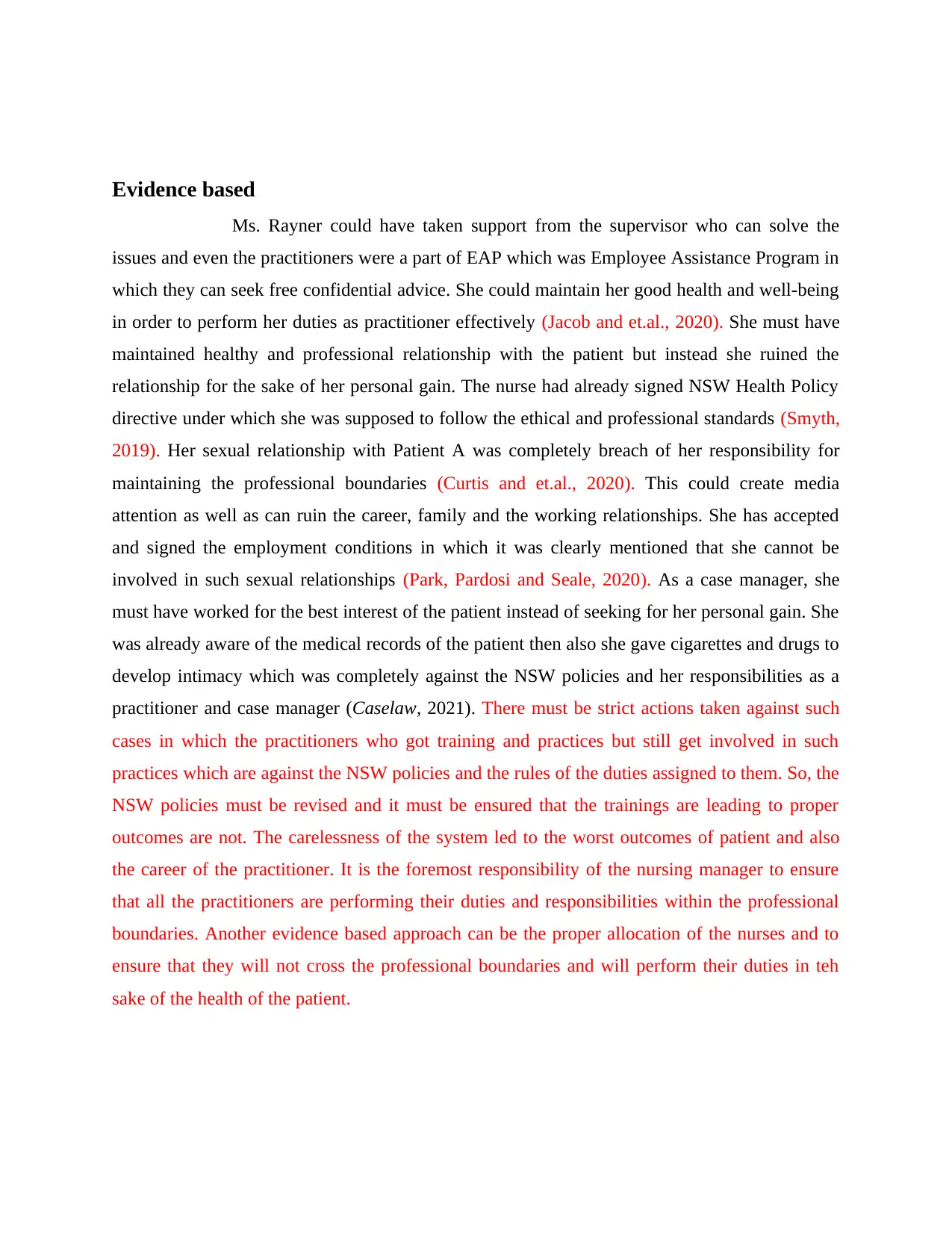
Evidence based
Ms. Rayner could have taken support from the supervisor who can solve the
issues and even the practitioners were a part of EAP which was Employee Assistance Program in
which they can seek free confidential advice. She could maintain her good health and well-being
in order to perform her duties as practitioner effectively (Jacob and et.al., 2020). She must have
maintained healthy and professional relationship with the patient but instead she ruined the
relationship for the sake of her personal gain. The nurse had already signed NSW Health Policy
directive under which she was supposed to follow the ethical and professional standards (Smyth,
2019). Her sexual relationship with Patient A was completely breach of her responsibility for
maintaining the professional boundaries (Curtis and et.al., 2020). This could create media
attention as well as can ruin the career, family and the working relationships. She has accepted
and signed the employment conditions in which it was clearly mentioned that she cannot be
involved in such sexual relationships (Park, Pardosi and Seale, 2020). As a case manager, she
must have worked for the best interest of the patient instead of seeking for her personal gain. She
was already aware of the medical records of the patient then also she gave cigarettes and drugs to
develop intimacy which was completely against the NSW policies and her responsibilities as a
practitioner and case manager (Caselaw, 2021). There must be strict actions taken against such
cases in which the practitioners who got training and practices but still get involved in such
practices which are against the NSW policies and the rules of the duties assigned to them. So, the
NSW policies must be revised and it must be ensured that the trainings are leading to proper
outcomes are not. The carelessness of the system led to the worst outcomes of patient and also
the career of the practitioner. It is the foremost responsibility of the nursing manager to ensure
that all the practitioners are performing their duties and responsibilities within the professional
boundaries. Another evidence based approach can be the proper allocation of the nurses and to
ensure that they will not cross the professional boundaries and will perform their duties in teh
sake of the health of the patient.
Ms. Rayner could have taken support from the supervisor who can solve the
issues and even the practitioners were a part of EAP which was Employee Assistance Program in
which they can seek free confidential advice. She could maintain her good health and well-being
in order to perform her duties as practitioner effectively (Jacob and et.al., 2020). She must have
maintained healthy and professional relationship with the patient but instead she ruined the
relationship for the sake of her personal gain. The nurse had already signed NSW Health Policy
directive under which she was supposed to follow the ethical and professional standards (Smyth,
2019). Her sexual relationship with Patient A was completely breach of her responsibility for
maintaining the professional boundaries (Curtis and et.al., 2020). This could create media
attention as well as can ruin the career, family and the working relationships. She has accepted
and signed the employment conditions in which it was clearly mentioned that she cannot be
involved in such sexual relationships (Park, Pardosi and Seale, 2020). As a case manager, she
must have worked for the best interest of the patient instead of seeking for her personal gain. She
was already aware of the medical records of the patient then also she gave cigarettes and drugs to
develop intimacy which was completely against the NSW policies and her responsibilities as a
practitioner and case manager (Caselaw, 2021). There must be strict actions taken against such
cases in which the practitioners who got training and practices but still get involved in such
practices which are against the NSW policies and the rules of the duties assigned to them. So, the
NSW policies must be revised and it must be ensured that the trainings are leading to proper
outcomes are not. The carelessness of the system led to the worst outcomes of patient and also
the career of the practitioner. It is the foremost responsibility of the nursing manager to ensure
that all the practitioners are performing their duties and responsibilities within the professional
boundaries. Another evidence based approach can be the proper allocation of the nurses and to
ensure that they will not cross the professional boundaries and will perform their duties in teh
sake of the health of the patient.
⊘ This is a preview!⊘
Do you want full access?
Subscribe today to unlock all pages.

Trusted by 1+ million students worldwide
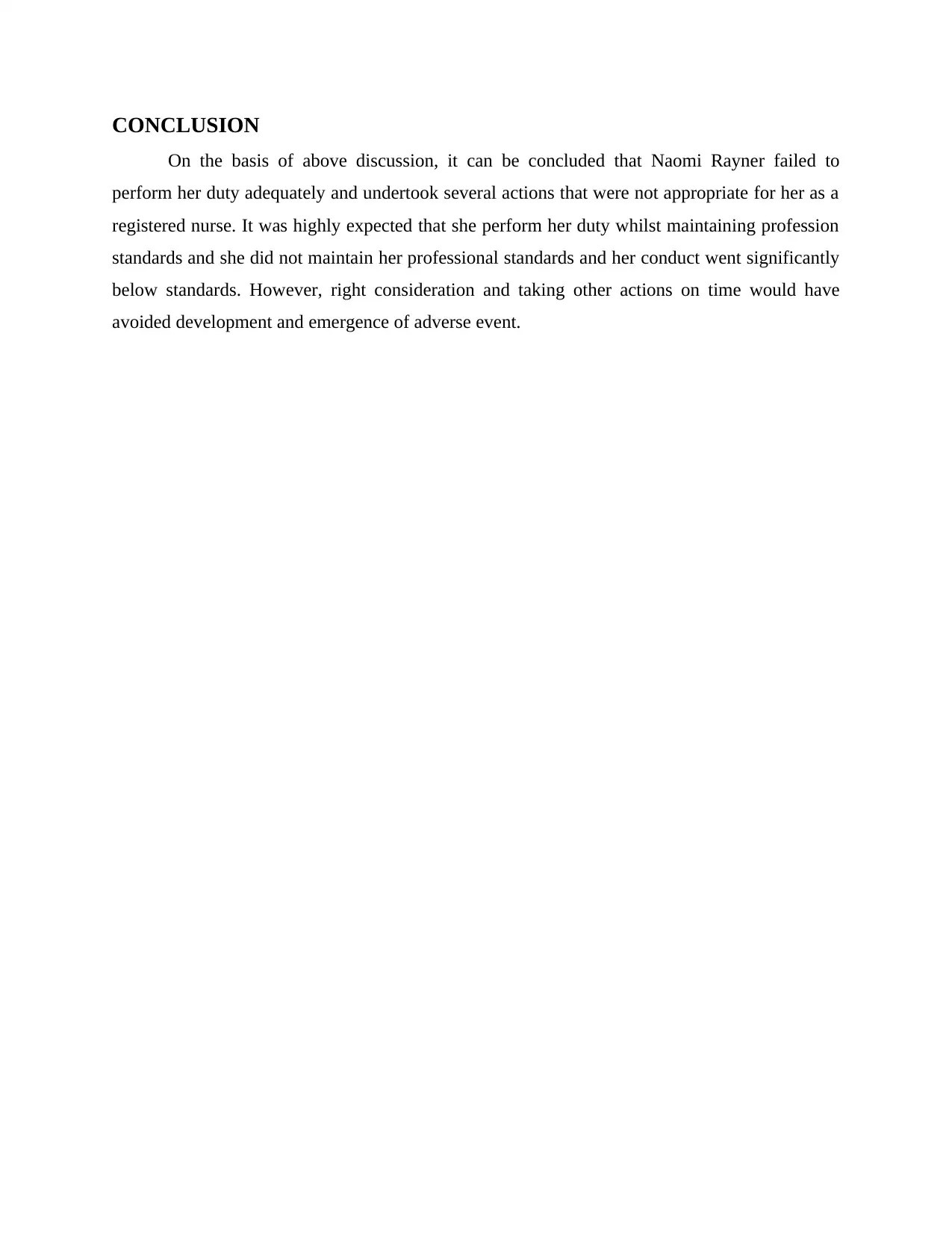
CONCLUSION
On the basis of above discussion, it can be concluded that Naomi Rayner failed to
perform her duty adequately and undertook several actions that were not appropriate for her as a
registered nurse. It was highly expected that she perform her duty whilst maintaining profession
standards and she did not maintain her professional standards and her conduct went significantly
below standards. However, right consideration and taking other actions on time would have
avoided development and emergence of adverse event.
On the basis of above discussion, it can be concluded that Naomi Rayner failed to
perform her duty adequately and undertook several actions that were not appropriate for her as a
registered nurse. It was highly expected that she perform her duty whilst maintaining profession
standards and she did not maintain her professional standards and her conduct went significantly
below standards. However, right consideration and taking other actions on time would have
avoided development and emergence of adverse event.
Paraphrase This Document
Need a fresh take? Get an instant paraphrase of this document with our AI Paraphraser
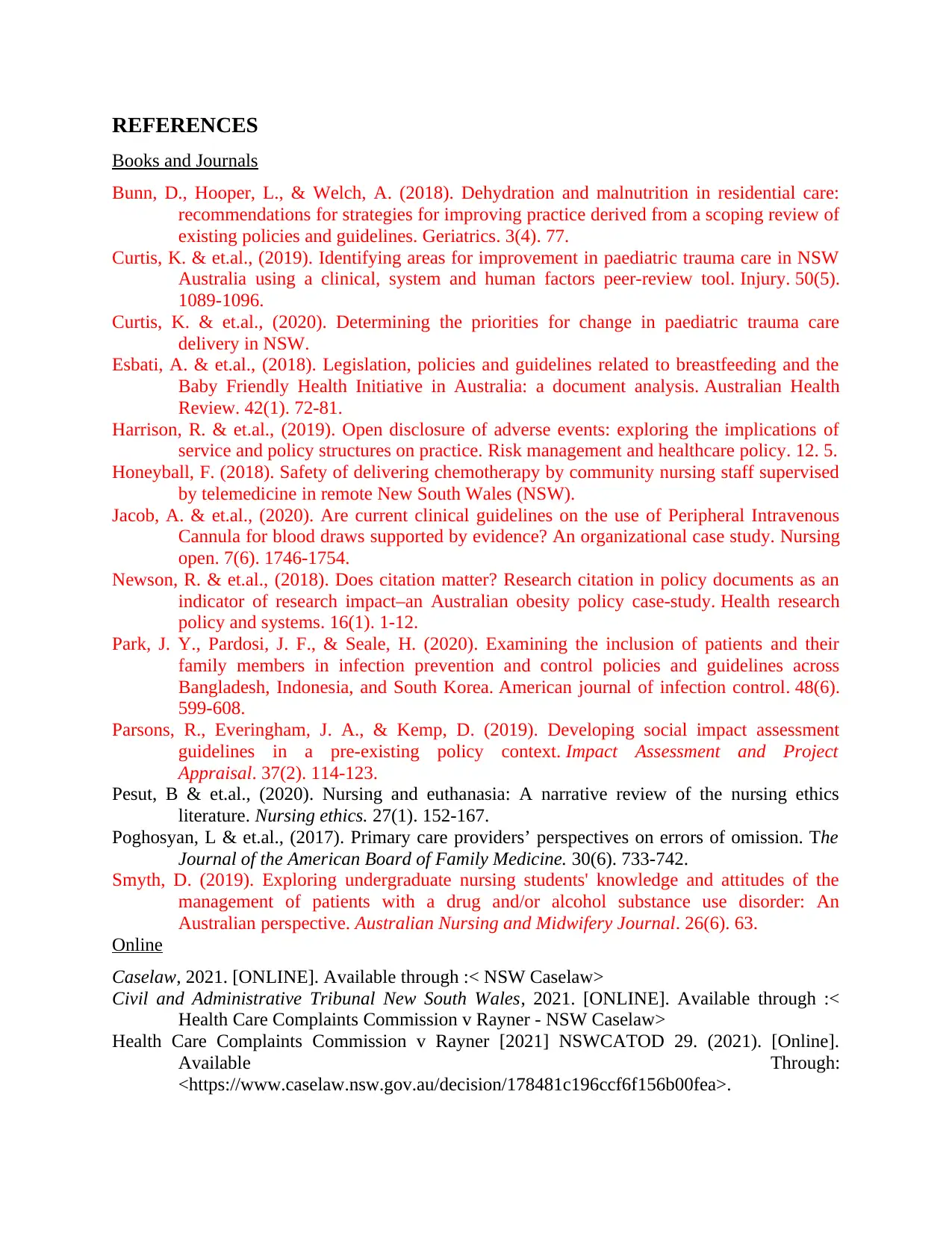
REFERENCES
Books and Journals
Bunn, D., Hooper, L., & Welch, A. (2018). Dehydration and malnutrition in residential care:
recommendations for strategies for improving practice derived from a scoping review of
existing policies and guidelines. Geriatrics. 3(4). 77.
Curtis, K. & et.al., (2019). Identifying areas for improvement in paediatric trauma care in NSW
Australia using a clinical, system and human factors peer-review tool. Injury. 50(5).
1089-1096.
Curtis, K. & et.al., (2020). Determining the priorities for change in paediatric trauma care
delivery in NSW.
Esbati, A. & et.al., (2018). Legislation, policies and guidelines related to breastfeeding and the
Baby Friendly Health Initiative in Australia: a document analysis. Australian Health
Review. 42(1). 72-81.
Harrison, R. & et.al., (2019). Open disclosure of adverse events: exploring the implications of
service and policy structures on practice. Risk management and healthcare policy. 12. 5.
Honeyball, F. (2018). Safety of delivering chemotherapy by community nursing staff supervised
by telemedicine in remote New South Wales (NSW).
Jacob, A. & et.al., (2020). Are current clinical guidelines on the use of Peripheral Intravenous
Cannula for blood draws supported by evidence? An organizational case study. Nursing
open. 7(6). 1746-1754.
Newson, R. & et.al., (2018). Does citation matter? Research citation in policy documents as an
indicator of research impact–an Australian obesity policy case-study. Health research
policy and systems. 16(1). 1-12.
Park, J. Y., Pardosi, J. F., & Seale, H. (2020). Examining the inclusion of patients and their
family members in infection prevention and control policies and guidelines across
Bangladesh, Indonesia, and South Korea. American journal of infection control. 48(6).
599-608.
Parsons, R., Everingham, J. A., & Kemp, D. (2019). Developing social impact assessment
guidelines in a pre-existing policy context. Impact Assessment and Project
Appraisal. 37(2). 114-123.
Pesut, B & et.al., (2020). Nursing and euthanasia: A narrative review of the nursing ethics
literature. Nursing ethics. 27(1). 152-167.
Poghosyan, L & et.al., (2017). Primary care providers’ perspectives on errors of omission. The
Journal of the American Board of Family Medicine. 30(6). 733-742.
Smyth, D. (2019). Exploring undergraduate nursing students' knowledge and attitudes of the
management of patients with a drug and/or alcohol substance use disorder: An
Australian perspective. Australian Nursing and Midwifery Journal. 26(6). 63.
Online
Caselaw, 2021. [ONLINE]. Available through :< NSW Caselaw>
Civil and Administrative Tribunal New South Wales, 2021. [ONLINE]. Available through :<
Health Care Complaints Commission v Rayner - NSW Caselaw>
Health Care Complaints Commission v Rayner [2021] NSWCATOD 29. (2021). [Online].
Available Through:
<https://www.caselaw.nsw.gov.au/decision/178481c196ccf6f156b00fea>.
Books and Journals
Bunn, D., Hooper, L., & Welch, A. (2018). Dehydration and malnutrition in residential care:
recommendations for strategies for improving practice derived from a scoping review of
existing policies and guidelines. Geriatrics. 3(4). 77.
Curtis, K. & et.al., (2019). Identifying areas for improvement in paediatric trauma care in NSW
Australia using a clinical, system and human factors peer-review tool. Injury. 50(5).
1089-1096.
Curtis, K. & et.al., (2020). Determining the priorities for change in paediatric trauma care
delivery in NSW.
Esbati, A. & et.al., (2018). Legislation, policies and guidelines related to breastfeeding and the
Baby Friendly Health Initiative in Australia: a document analysis. Australian Health
Review. 42(1). 72-81.
Harrison, R. & et.al., (2019). Open disclosure of adverse events: exploring the implications of
service and policy structures on practice. Risk management and healthcare policy. 12. 5.
Honeyball, F. (2018). Safety of delivering chemotherapy by community nursing staff supervised
by telemedicine in remote New South Wales (NSW).
Jacob, A. & et.al., (2020). Are current clinical guidelines on the use of Peripheral Intravenous
Cannula for blood draws supported by evidence? An organizational case study. Nursing
open. 7(6). 1746-1754.
Newson, R. & et.al., (2018). Does citation matter? Research citation in policy documents as an
indicator of research impact–an Australian obesity policy case-study. Health research
policy and systems. 16(1). 1-12.
Park, J. Y., Pardosi, J. F., & Seale, H. (2020). Examining the inclusion of patients and their
family members in infection prevention and control policies and guidelines across
Bangladesh, Indonesia, and South Korea. American journal of infection control. 48(6).
599-608.
Parsons, R., Everingham, J. A., & Kemp, D. (2019). Developing social impact assessment
guidelines in a pre-existing policy context. Impact Assessment and Project
Appraisal. 37(2). 114-123.
Pesut, B & et.al., (2020). Nursing and euthanasia: A narrative review of the nursing ethics
literature. Nursing ethics. 27(1). 152-167.
Poghosyan, L & et.al., (2017). Primary care providers’ perspectives on errors of omission. The
Journal of the American Board of Family Medicine. 30(6). 733-742.
Smyth, D. (2019). Exploring undergraduate nursing students' knowledge and attitudes of the
management of patients with a drug and/or alcohol substance use disorder: An
Australian perspective. Australian Nursing and Midwifery Journal. 26(6). 63.
Online
Caselaw, 2021. [ONLINE]. Available through :< NSW Caselaw>
Civil and Administrative Tribunal New South Wales, 2021. [ONLINE]. Available through :<
Health Care Complaints Commission v Rayner - NSW Caselaw>
Health Care Complaints Commission v Rayner [2021] NSWCATOD 29. (2021). [Online].
Available Through:
<https://www.caselaw.nsw.gov.au/decision/178481c196ccf6f156b00fea>.
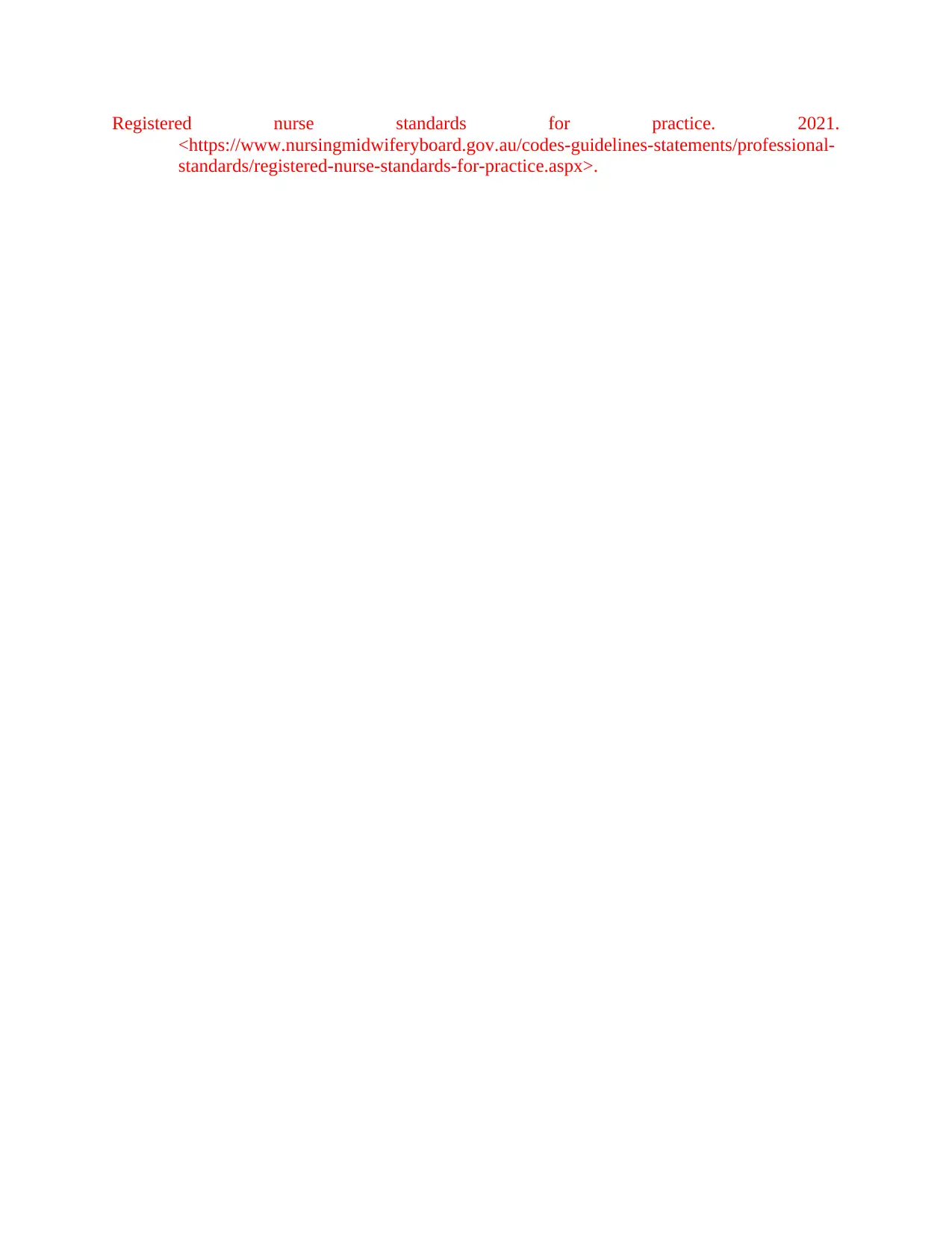
Registered nurse standards for practice. 2021.
<https://www.nursingmidwiferyboard.gov.au/codes-guidelines-statements/professional-
standards/registered-nurse-standards-for-practice.aspx>.
<https://www.nursingmidwiferyboard.gov.au/codes-guidelines-statements/professional-
standards/registered-nurse-standards-for-practice.aspx>.
⊘ This is a preview!⊘
Do you want full access?
Subscribe today to unlock all pages.

Trusted by 1+ million students worldwide
1 out of 9
Related Documents
Your All-in-One AI-Powered Toolkit for Academic Success.
+13062052269
info@desklib.com
Available 24*7 on WhatsApp / Email
![[object Object]](/_next/static/media/star-bottom.7253800d.svg)
Unlock your academic potential
Copyright © 2020–2025 A2Z Services. All Rights Reserved. Developed and managed by ZUCOL.





